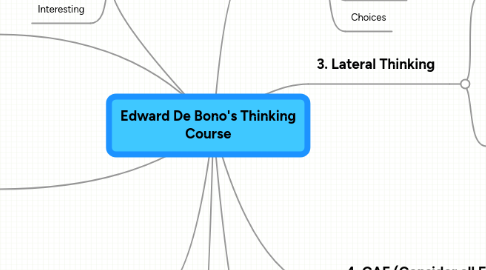
1. 1. PMI
1.1. Purpose
1.1.1. A method to focus attention on different aspects of a situation
1.2. Postives
1.3. Minuses
1.4. Interesting
2. 6. FI-FO (inFormation In - inFormation Out)
2.1. Purpose
2.1.1. Identify gaps in information requirements
2.2. How
2.2.1. CAF
2.2.2. Identify gaps in information
3. 7. EBS (Examine both sides)
3.1. Purpose
3.1.1. explore two ideas
3.2. how
3.2.1. PMI for each side
3.2.2. ADI
3.2.2.1. Agreement
3.2.2.2. Disagreement
3.2.2.3. Irrelevant
4. 8. Logic bubbles
4.1. Purpose
4.1.1. a method to think about how individuals will rationally act within their surroundings
4.2. How
4.2.1. perception circumstance
4.2.2. structure
4.2.3. context & relationship
5. 9. OPV (Other Peoples Views)
5.1. How
5.1.1. Identify other relevant actors
5.1.2. See their perspective
6. 3. Lateral Thinking
6.1. po (provocative operation)
6.1.1. purpose
6.1.1.1. a process to trigger new idea
6.1.2. methods
6.1.2.1. stepping stone method
6.1.2.1.1. use provocative statement
6.1.2.2. escape method
6.1.2.2.1. drop feature of situation
6.1.2.3. random stimulation
6.1.2.3.1. e.g. seed a noun from dictionary
6.2. ps (provocative statement)
6.2.1. purpose
6.2.1.1. a stimulus to trigger a new idea
6.2.2. types
6.2.2.1. reversal
6.2.2.2. exaggeration
6.2.2.3. distortion
6.2.2.4. wishful thinking
6.2.2.5. outrageous
7. 2. APC
7.1. Purpose
7.1.1. A method to focus attention on alternatives to current situation
7.2. Alternatives
7.3. Possibilities
7.4. Choices
8. 4. CAF (Consider all Factors)
8.1. Purpose
8.1.1. A method to exhaustively Identify all the factors relevant to a situation
8.2. How
8.2.1. Exhaustively identify all relevant factors
8.2.2. Identify what has been left out?
8.2.3. What else needs to be considered?
9. 5. C&S (Consequence and Sequel)
9.1. Purpose: A method to focus attention on consequences of decision over different periods of time
9.1.1. Immediate
9.1.1.1. -1 year
9.1.2. Short-term
9.1.2.1. 1-5 years
9.1.3. Medium
9.1.3.1. 5-20 years
9.1.4. Long term
9.1.4.1. 20+ years
